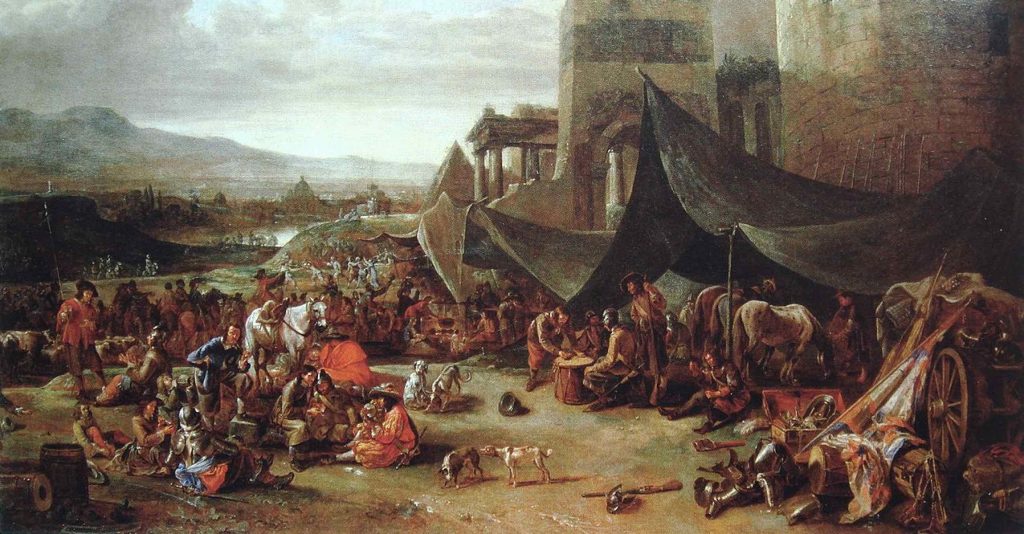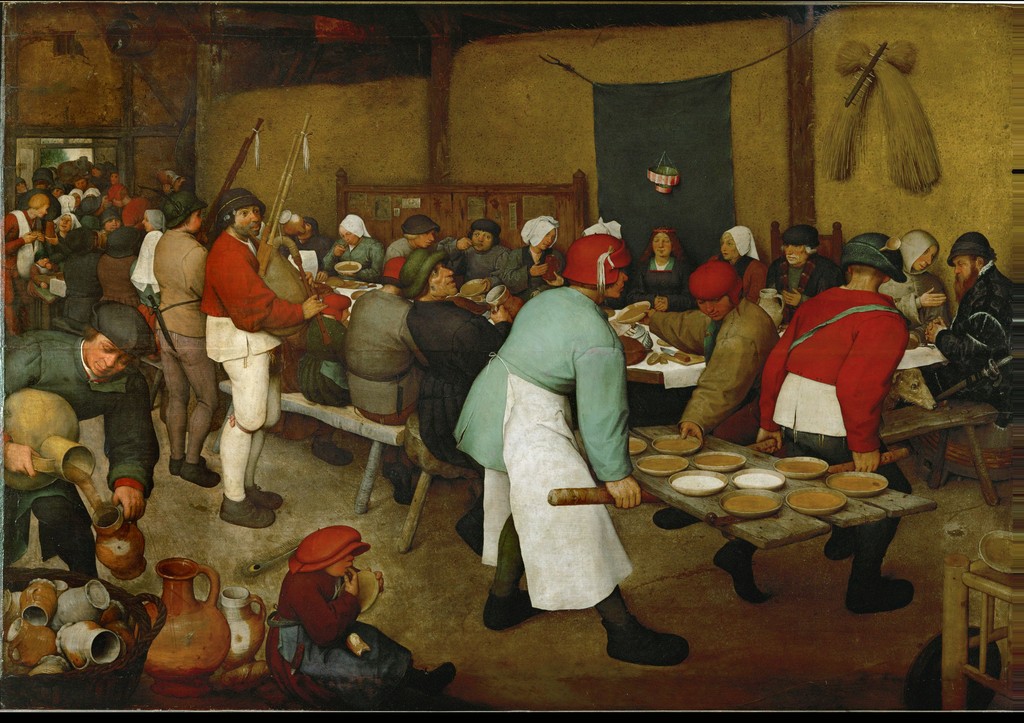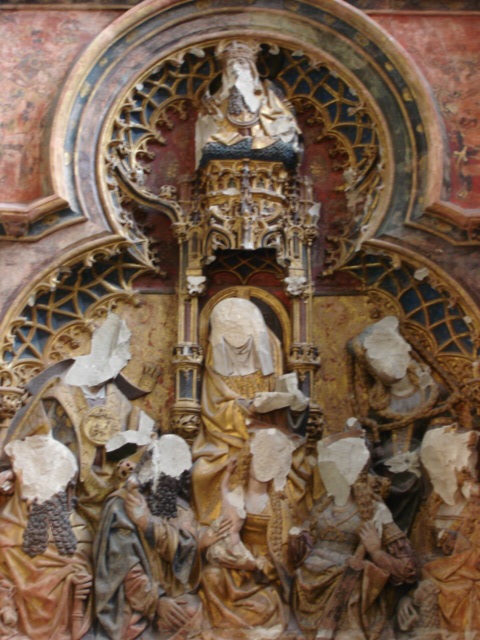Chapter 10.5: The End of the Renaissance
Scholars believe the demise of the Renaissance was the result of several compounding factors. By the end of the 15th century, numerous wars had plagued the Italian peninsula. Spanish, French, and German invaders battling for Italian territories caused disruption and instability in the region. Particularly gruesome was the Sack of the city of Rome that took place in 1527.

Often cited as the end of the Italian Renaissance, the Sack of Rome impacted the histories of Europe, Italy, and Catholicism, creating lasting ripple effects throughout world culture and politics. The Sack of Rome on 6 May 1527 was a military event carried out in Rome by the mutinous troops of Charles V.
Rome, which had been a center of Italian High Renaissance culture and patronage prior to the Sack, suffered depopulation and economic collapse, causing artists and thinkers to scatter. The city’s population dropped from some 55,000 before the attack to 10,000 afterward. An estimated 6,000 to 12,000 people were murdered. Many Imperial soldiers also died in the aftermath, largely from diseases caused by masses of unburied corpses in the streets. Pillaging finally ended in February 1528, eight months after the initial attack, when the city’s food supply ran out, there was no one left to ransom, and plague appeared. It would take Rome decades to rebuild. Clement VII and later Popes would continue artistic patronage and building projects in the city, but a perceived golden age had passed. The psychological impact of the Sack of Rome cannot be underestimated. The epicenter of Renaissance thought is now in ruins, and with it, the great hope and promise of the Renaissance.
The second event that contributed to the end of the Renaissance is the Protestant Reformation.
Impact of the Protestant Reformation
The Protestant Reformation was a religious movement that occurred in Western Europe during the 16th century that resulted in the theological divide between Roman Catholics and Protestants. This movement created a North-South split in Europe, where generally, Northern countries became Protestant, while Southern countries remained Catholic. Protestant theology centered on the individual relationship between the worshiper and the divine, and accordingly, the Reformation’s artistic movement focused on the individual’s personal relationship with God. This was reflected in a number of common people and day-to-day scenes depicted in art.
The Reformation ushered in a new artistic tradition that highlighted the Protestant belief system and diverged drastically from southern European humanist art produced during the High Renaissance. Reformation art embraced Protestant values, although the amount of religious art produced in Protestant countries was hugely reduced (largely because a huge patron for the arts—the Catholic Church—was no longer active in these countries). Instead, many artists in Protestant countries diversified into secular forms of art like history painting, landscapes, portraiture, and still life.
Art that portrayed religious figures or scenes followed Protestant theology by depicting people and stories accurately and clearly and emphasized salvation through divine grace rather than through personal deeds or by the intervention of church bureaucracy. This is the direct influence of one major criticism of the Catholic Church during the Reformation—that painters created biblical scenes that strayed from their true story, were hard to identify, and were embellished with painterly effects instead of focusing on the theological message. In terms of subject matter, iconic images of Christ and scenes from the Passion became less frequent, as did portrayals of the saints and clergy. Instead, narrative scenes from the Bible and moralistic depictions of modern life became prevalent.
The Protestant Reformation also capitalized on the popularity of printmaking in northern Europe. Printmaking allowed images to be mass-produced and widely available to the public at a low cost. The Protestant church was, therefore, able to bring its theology to the people through portable, inexpensive visual media. This allowed for the widespread availability of visually persuasive imagery. With the great development of the engraving and printmaking market in Antwerp in the 16th century, the public was provided with accessible and affordable images. Many artists provided drawings to book and print publishers.
Iconoclasm and Resistance to Idolatry

All forms of Protestantism showed a degree of hostility to religious images, especially sculpture and large paintings, considering them forms of idol worship. After the early years of the Reformation, artists in Protestant areas painted far fewer religious subjects for public display, partly because religious art had long been associated with the Catholic Church. However, there was a conscious effort to develop a Protestant iconography of Bible images in book illustrations and prints.
During the early Reformation, some artists made paintings for churches that depicted the leaders of the Reformation in ways very similar to Catholic saints. Later, Protestant taste turned away from the display of religious scenes in churches, although some continued to be displayed in homes.
There was also a reaction against images from classical mythology, the other manifestation of the High Renaissance at the time. This brought about a style that was more directly related to accurately portraying the present times. For example, Bruegel’s Wedding Feast portrays a Flemish-peasant wedding dinner in a barn. It makes no reference to any religious, historical, or classical events and merely gives insight into the everyday life of the Flemish peasant.
The Protestant Reformation induced a wave of iconoclasm, or the destruction of religious imagery, among the more radical evangelists. Protestant leaders, especially Huldrych Zwingli and John Calvin, actively eliminated imagery from their churches and regarded the great majority of religious images as idolatrous—even plain crosses. On the other hand, Martin Luther encouraged the display of a restricted range of religious imagery in churches. For the most part, however, Reformation iconoclasm resulted in a disappearance of religious figurative art, compared with the amount of secular pieces that emerged.

Media Attributions
- Figure 1. Johannes Lingelbach, Sack of Rome of 1527. 17th Century (Image source: L’Histoire April-June 2009, p.74, via Wikimedia Commons) is licensed under a Public Domain license
- Figure 2. Pieter Bruegel, Peasant Wedding. Oil on oak wood, 1568: Bruegael’s Peasant Wedding is a painting that captures the Protestant Reformation artistic tradition: focusing on scenes from modern life rather than religious or classical themes (Image source: Erich Lessing/ART RESOURCE, N.Y. via Artstor. Used with permission, for education use only).
- Figure 3. Iconoclasm: Catholic Altar Piece: Altar piece in St. Martin’s Cathedral, Utrecht, attacked in the Protestant iconoclasm in 1572. This retable became visible again after restoration in 1919 removed the false wall placed in front of it (Image source: Pepijntje via Wikimedia Commons) is licensed under a CC BY-SA (Attribution ShareAlike) license
Candela Citations
- Sack of Rome (1527). Authored by: Wikipedia. Retrieved from: https://en.wikipedia.org/wiki/Sack_of_Rome_(1527). License: CC BY-SA: Attribution-ShareAlike
- The Northern Renaissance. Authored by: Boundless. Provided by: Lumen Learning. Retrieved from: https://www.collegesidekick.com/study-guides/boundless-arthistory/the-northern-renaissance. License: CC BY-SA: Attribution-ShareAlike
- Renaissance. Authored by: History.com. Retrieved from: https://www.history.com/articles/renaissance. License: All Rights Reserved

